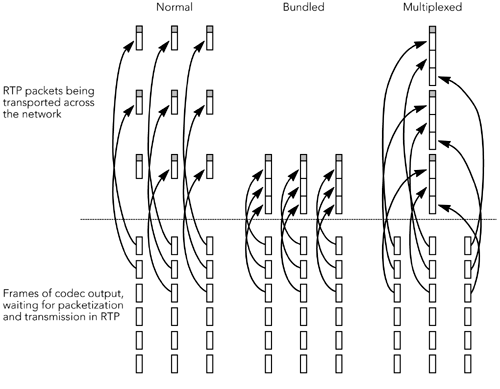The Motivation for Multiplexing
| Header compression reduces the size of the headers of a single RTP stream, on a hop-by-hop basis. It provides very efficient transport but requires cooperation from the network (because header compression works hop-by-hop , rather than end-to-end). Header compression adds to the load on routers in terms of additional computation and flow-specific state, both of which may be unacceptable in systems that have to support many hundreds, or even thousands, of simultaneous RTP streams. The traditional solution to the issues of computation and state within the network has been to push the complexity to the edge, simplifying the center of the network at the expense of additional complexity at the edges: the end-to-end argument. Application of this solution leads to the suggestion that headers should be reduced end-to-end if possible. You can reduce the header in this way by performing header compression end-to-end, thereby reducing the size of each header, or by placing multiple payloads within each packet to reduce the number of headers. Applying RTP header compression end-to-end is possible, but unfortunately it provides little benefit. Even if the RTP headers were removed entirely, the UDP/IP headers would still be present. Thus a 28-octet overhead would remain for the typical IPv4 case, a size that is clearly unacceptable when the payload is, for example, a 14-octet audio frame. So there is only one possible end-to-end solution: Place multiple payloads within each packet, to amortize the overhead due to UDP/IP headers. The multiple frames of payload data may come from a single stream or from multiple streams, as shown in Figure 12.1. Placing multiple frames of payload data from a single stream into each RTP packet is known is bundling . As explained in Chapter 4, RTP Data Transfer Protocol, bundling is an inherent part of RTP and needs no special support. It is very effective at reducing the header overhead, but it imposes additional delay on the media stream because a packet cannot be sent until all the bundled data is present. Figure 12.1. Bundling versus Multiplexing The alternative, multiplexing , is the process by which multiple frames of payload data, from different streams, are placed into a single packet for transport. Multiplexing avoids the delay penalty inherent in bundling, and in some cases it can significantly improve efficiency. It is, however, not without problems, which may render it unsuitable in many cases:
Despite these issues, in some cases it may still be desirable to multiplex RTP streams. The most common example is the case in which a large number of essentially identical flows are being transferred between two points, something that occurs often when voice-over-IP is being used as a backbone "trunk" to replace conventional telephone lines. Multiplexing is not directly supported within RTP. If multiplexing streams within RTP is desired, one of the extensions described in this chapter must be used. |
EAN: 2147483647
Pages: 108
- Key #1: Delight Your Customers with Speed and Quality
- Key #2: Improve Your Processes
- Key #4: Base Decisions on Data and Facts
- Making Improvements That Last: An Illustrated Guide to DMAIC and the Lean Six Sigma Toolkit
- The Experience of Making Improvements: What Its Like to Work on Lean Six Sigma Projects
